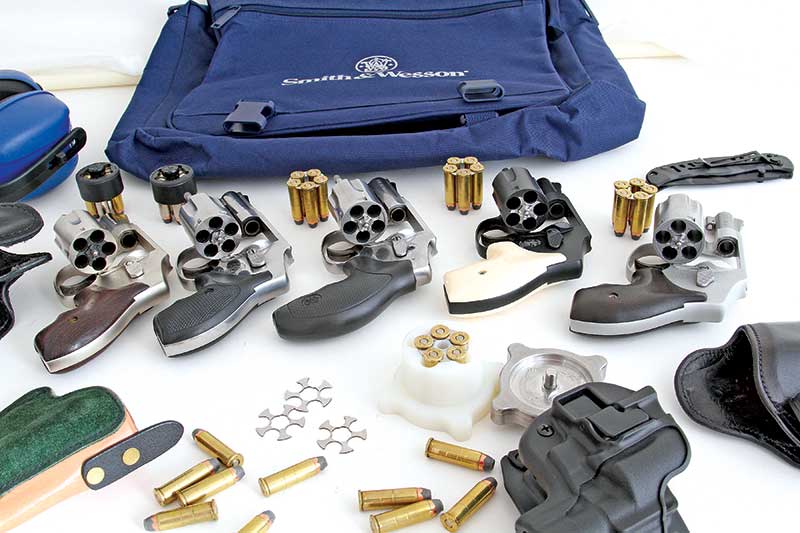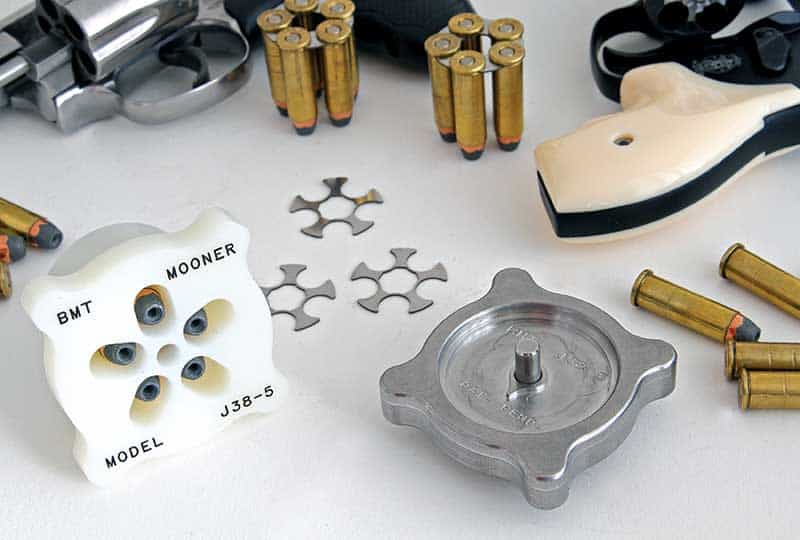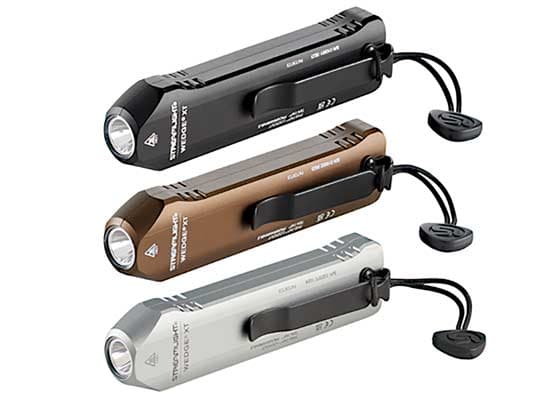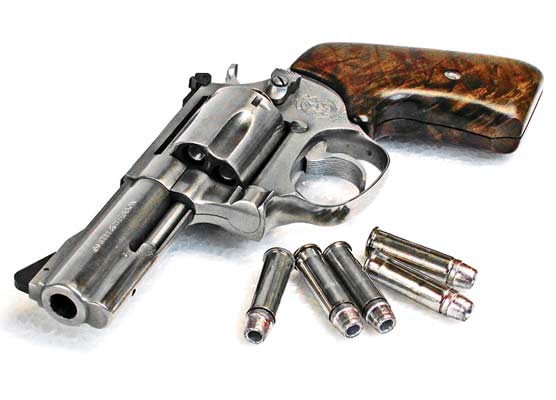Mooning Smiths?
Pro Series J-Frames
Smith & Wesson must have known they had a winner when the first J-frame revolver was built on Oct. 24, 1950. I wonder if they had any idea just how popular these light, compact revolvers would become.
Sixty years later the J-frame Smiths are selling better then ever. These compact revolvers are tremendously popular with private citizens empowered by recent state-legislated “shall issue” carry permits. And although most law enforcement officers now carry autopistols as their primary duty arm, tens of thousands (hundreds of thousands?) of J-frames still serve in a backup role.
The J-frames draw their share of criticism. Critics say they are too small, too short-barreled, too feeble, too hard to shoot, have too much recoil and are too slow to reload. But they do have one big advantage. They are too handy to get left at home.

S&W J-frames from left: Regular style satin nickel 442, 640; Pro Series 640,
442 and 642. The Pro Series models provide all the features of regular J-frames
and can be reloaded with single rounds, with speedloaders or speed strips, but
add the option of using moon clips. The two 442s and the 642 wear aftermarket
“Secret Service” grips from Eagle Grips, my favorites for J-frame revolvers.
Versatile Pro Series
The examples shown here are part of the “Pro Series.” They address the only criticism I consider as valid, the issue of reloading. These models have the rear of the cylinder machined to accept moon clips for faster reloading.
The moon clips provided with these J-frames (three with each revolver) are made of thin but very strong, springy steel. The system on these J-frames does not sacrifice any other methods of operation. If you like, you can load the cylinder with individual rounds. The ridge along the circumference of the cylinder, and the ejector star, engage the cartridge rims. Cartridges headspace properly for normal firing and eject when the ejector rod is activated.
I also tried reloading with some Safariland speedloaders I had on hand, and these too worked perfectly. In short, whatever method you use to shoot and reload any other J-frame works just fine with these revolvers. The moon clips simply add another option.
Along with a couple of friends, both very good shooters, I tried timing reloads, using a CED timer to measure from shot to shot. Both onscreen and in person I’ve seen Jerry Miculek consistently do revolver reloads in the 1.5 second range with some around a second flat. Two points: (1) these are with .45 ACP revolvers using short, fat, FMJ cartridges which funnel easily into the charge holes, and (2) Jerry is the best revolver shooter in the world.
On the other hand: (1) we were using .38 Special cartridges which are long and skinny, with flat profile JHP bullets, and (2) we are not the best revolver shooters in the world. We were consistently in the low four-second range (shot to shot). My best time was 3.20 and my pal Steve beat me with a 3.05.
The biggest delay, we found, was due to item (1), the long skinny nature of .38 Spl. cartridges. Seldom would they all align with the cylinder charge holes without a bit of “jiggling” to get them started. I also timed some reloads with the Safariland speedloaders and found them almost as fast.
Easy Does It
As the afternoon wore on we found the moon clips gave more consistent reloads. Oddly enough the consistency came not so much from loading the fresh cartridges as from ejecting the fired cases. These little revolvers have a short ejector rod. When not using the moon clips, occasionally a fired case wouldn’t completely eject and would have to be pulled out. Worse yet, once or twice a case got caught under the ejector star, making it darn hard to clear.
With the moon clips there were no such hang-ups. One good push on the ejector rod and all five cases came out together, every time. This consistency alone makes the moon clips worthwhile, in my view. All regular J-frame operating features are retained. MSRP on the Pro Series 442/642 models (.38 Spl. +P rated) is $640 vs. $616 for standard versions, certainly a modest surcharge for adding moon-clip capability.
We used the BMT “Mooner” tool for loading clips and found it performed superbly. Loading and unloading clips manually was a pain, and sometimes resulted in clips being bent. The Mooner tool is cleverly designed and well made. Set a clip in place, drop five rounds in the slots, set the alloy “wheel” on top, rotate it 360 degrees and the cartridges are loaded.
To unload, turn the wheel over, rotate again and the fired cases are removed from the clip. The Mooner is made for other cartridges and cylinder sizes (e.g. 6-, 7- and 8-shot S&Ws). Let your friends see you use it and you’ll never have to load a clip again. Like Tom Sawyer’s friends whitewashing the fence, they just have to try it. Since you’re a good friend you just have to let them.
For a video of the custom J-frames and BMT Mooner in use see www.davesgunpages.com under “Guns & Accessories.”
For more info: Smith & Wesson (800) 331-0852, www.smith-wesson.com; BMT Mooner (605) 348-3538
Subscribe To American Handgunner

Get More Revolver Content Every Week!
Sign up for the Wheelgun Wednesday newsletter here:






